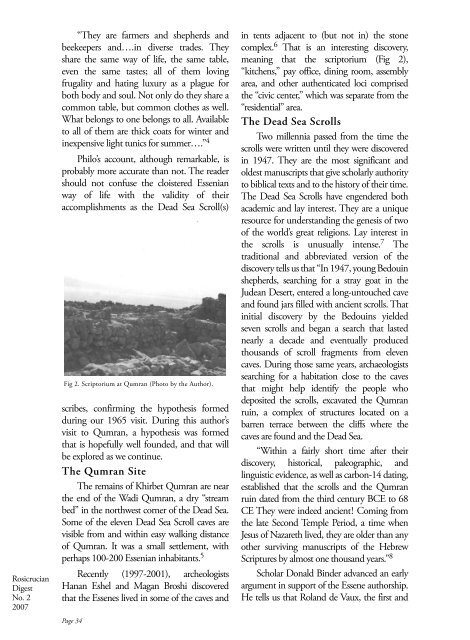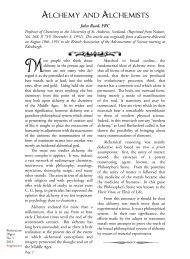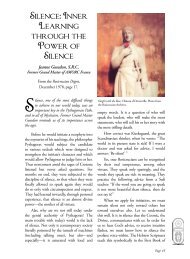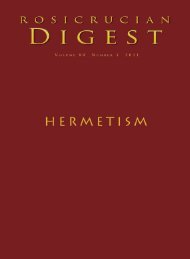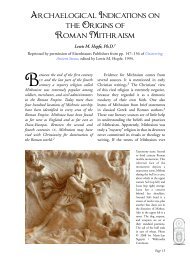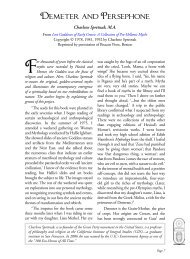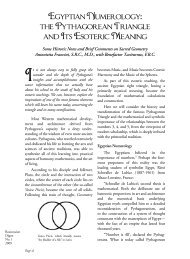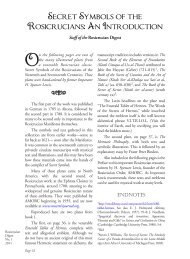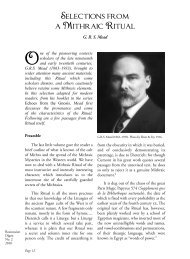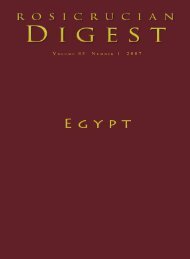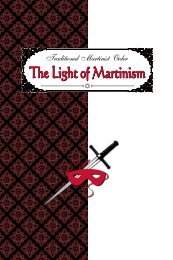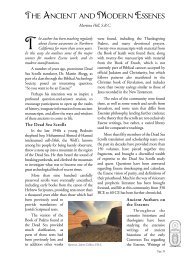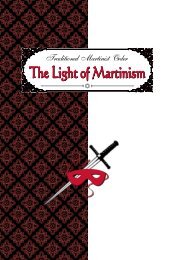Rosicrucian Digest Vol 85 Number 2 2007 - Rosicrucian Order
Rosicrucian Digest Vol 85 Number 2 2007 - Rosicrucian Order
Rosicrucian Digest Vol 85 Number 2 2007 - Rosicrucian Order
Create successful ePaper yourself
Turn your PDF publications into a flip-book with our unique Google optimized e-Paper software.
<strong>Rosicrucian</strong><br />
<strong>Digest</strong><br />
No. 2<br />
<strong>2007</strong><br />
“They are farmers and shepherds and<br />
beekeepers and….in diverse trades. They<br />
share the same way of life, the same table,<br />
even the same tastes; all of them loving<br />
frugality and hating luxury as a plague for<br />
both body and soul. Not only do they share a<br />
common table, but common clothes as well.<br />
What belongs to one belongs to all. Available<br />
to all of them are thick coats for winter and<br />
inexpensive light tunics for summer….” 4<br />
Philo’s account, although remarkable, is<br />
probably more accurate than not. The reader<br />
should not confuse the cloistered Essenian<br />
way of life with the validity of their<br />
accomplishments as the Dead Sea Scroll(s)<br />
Fig 2. Scriptorium at Qumran (Photo by the Author).<br />
scribes, confirming the hypothesis formed<br />
during our 1965 visit. During this author’s<br />
visit to Qumran, a hypothesis was formed<br />
that is hopefully well founded, and that will<br />
be explored as we continue.<br />
The Qumran Site<br />
The remains of Khirbet Qumran are near<br />
the end of the Wadi Qumran, a dry “stream<br />
bed” in the northwest corner of the Dead Sea.<br />
Some of the eleven Dead Sea Scroll caves are<br />
visible from and within easy walking distance<br />
of Qumran. It was a small settlement, with<br />
perhaps 100-200 Essenian inhabitants. 5<br />
Recently (1997-2001), archeologists<br />
Hanan Eshel and Magan Broshi discovered<br />
that the Essenes lived in some of the caves and<br />
Page 34<br />
in tents adjacent to (but not in) the stone<br />
complex. 6 That is an interesting discovery,<br />
meaning that the scriptorium (Fig 2),<br />
“kitchens,” pay office, dining room, assembly<br />
area, and other authenticated loci comprised<br />
the “civic center,” which was separate from the<br />
“residential” area.<br />
The Dead Sea Scrolls<br />
Two millennia passed from the time the<br />
scrolls were written until they were discovered<br />
in 1947. They are the most significant and<br />
oldest manuscripts that give scholarly authority<br />
to biblical texts and to the history of their time.<br />
The Dead Sea Scrolls have engendered both<br />
academic and lay interest. They are a unique<br />
resource for understanding the genesis of two<br />
of the world’s great religions. Lay interest in<br />
the scrolls is unusually intense. 7 The<br />
traditional and abbreviated version of the<br />
discovery tells us that “In 1947, young Bedouin<br />
shepherds, searching for a stray goat in the<br />
Judean Desert, entered a long-untouched cave<br />
and found jars filled with ancient scrolls. That<br />
initial discovery by the Bedouins yielded<br />
seven scrolls and began a search that lasted<br />
nearly a decade and eventually produced<br />
thousands of scroll fragments from eleven<br />
caves. During those same years, archaeologists<br />
searching for a habitation close to the caves<br />
that might help identify the people who<br />
deposited the scrolls, excavated the Qumran<br />
ruin, a complex of structures located on a<br />
barren terrace between the cliffs where the<br />
caves are found and the Dead Sea.<br />
“Within a fairly short time after their<br />
discovery, historical, paleographic, and<br />
linguistic evidence, as well as carbon-14 dating,<br />
established that the scrolls and the Qumran<br />
ruin dated from the third century BCE to 68<br />
CE They were indeed ancient! Coming from<br />
the late Second Temple Period, a time when<br />
Jesus of Nazareth lived, they are older than any<br />
other surviving manuscripts of the Hebrew<br />
Scriptures by almost one thousand years.” 8<br />
Scholar Donald Binder advanced an early<br />
argument in support of the Essene authorship.<br />
He tells us that Roland de Vaux, the first and


